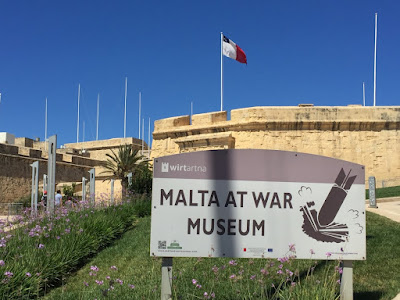Malta's location at the center of the Mediterranean has made it a strategic objective for millennia, and it has been besieged and/or conquered many times. The two most prominent battles for Malta were in 1565, when the Turkish fleet was ascendent (The Great Siege of Malta), and in 1940-1943, when the Italians and the Germans attempted to wrest the islands from British control in WWII. In the former case, the Knights of Malta held out and eventually drove the Turks away. Ottoman sea power was decisively diminished later at the Battle of Lepanto, in 1572 (the "naval," as Cervantes, a participant, would say). Although Hitler and Mussolini had jointly approved a combined sea- and air-born invasion of Malta, for a variety of reasons, it never came to pass. For the Germans, Malta was of surpassing importance in protecting the flow of supplies to Rommel, then on his way, via Egypt, to the oil fields of Arabia. Germany's only other source of petroleum was Romania.
The Siege of Malta in WWII was a strictly air-born siege, focusing on the island, its defenses, and Allied efforts to re-supply and strengthen what Churchill referred to as his "unsinkable aircraft carrier." Between June 11th, 1940, and July 20th, 1943, the Maltese and their defenders suffered 3,340 air raids. Hundreds of planes were lost, scores of naval and merchant ships were sunk, along with thousands of casualties, mostly combatants. Under nearly continuous bombardment, Malta was ravaged, and there would have been more civilian casualties had it not been for the air raid shelters dug into that creamy soft limestone. The Malta War Museum deals with all of Malta's war involvements, but the Malta At War Museum deals only with WWII, my interest. Plus, the latter includes a tour of one of the nearby air raid shelters. A stirring nearly contemporaneous account of it all is the
Victory At Sea episode "Mediterranean Mosaic", which incorporated much of the British
Malta G. C. war-time "documentary" commanded by George VI himself and narrated by Lt. Laurence Olivier. FWIW. Plus you get to see a significant bit of television and documentary history and hear some great music.
 |
It's quite a crowded little museum, difficult for photography; when the war
started there were only a handful of Gloucester Gladiator bi-planes available
for Malta's defense; "Blood,"" Sweat," and "Tears" were the names of the last three;
then many Hawker Hurricanes arrived and were mostly butchered by the
faster German 109s; when enough Spitfires finally arrived, the tide began
to turn from Axis to Allied air superiority |
 |
| German and Italian war craft over Malta |
 |
| German bombs |
 |
About Malta and the George Cross; continuous showing of Malta G. C.; the
only time the award had been given to a whole population |
 |
...of the 55 convoy ships bound for Malta, 1940-42, 22 were sunk...11 forced to
turn back...of 31 merchant ships bound singly for Malta, 9 were sunk...the
Royal Navy lost 32 ships escorting the convoys (including a battleship and
an aircraft carrier) |
 |
| Anti-aircraft battery |
 |
| More about the George Cross |
 |
The US tanker Ohio; Roosevelt had dispatched her at
Churchill's desperate plea; bombed and torpedoed as she
crossed the Mediterranean, she was finally towed into
the Grand Harbor where, after unloading what was left
of her cargo, she broke in half and sank; the American
carrier Wasp was also instrumental in relieving Malta,
delivering several runs of Spifires |
 |
| In the air raid shelter now, bunks... |
 |
| Map of the shelter, Coronation Gardens |
 |
| First aid station |
 |
WWII ended less than two years before I was born; not so
remote, to me anyway |






















No comments:
Post a Comment